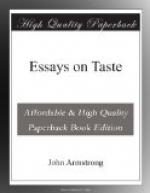Armstrong, in addition to his hostility to formal criticism and his confidence in the natural man, reveals three other tendencies which later eighteenth-century critics elaborated. Like Edward Young in his Conjectures on Original Composition, 1759, Armstrong opposes slavish imitation of ancient models and declares that the writer should “catch their graces without affecting it [them]” so that his “own original characteristical manner will still distinguish itself."[3] Armstrong emphasizes exquisiteness of perception as the basis for taste: the more exquisite the mind, the more is it able to discriminate among the various degrees of the beautiful and the deformed. Although later critics repudiate Armstrong’s moral discrimination, they transform it into a refined discrimination of aesthetic qualities. Finally, by suggesting that the man of genius differs from the man of taste by his ability to handle a medium, Armstrong implies the possibility of a technical criticism in terms of the writer’s craft, apart from moral judgment.
[Footnote 3: Ibid., II, 168.]
Although the works of Cooper and Armstrong elicited contrasting popular reactions—Letters concerning Taste running into four editions from 1755 to 1771 and Armstrong’s writings, with the exception of The Art of Preserving Health, never winning much public favor—neither writer exerted a strong critical influence. Cooper did not reassess or change significantly the assumptions of Shaftesbury and Hutcheson. His work was primarily a popularization of their ideas, and, in its enthusiastic language, its emphasis on sensibility, and its epistolary form, it seems directed at flattering a female audience. Armstrong’s remarks on taste, written in imitation of the simplicity and clarity of the rational tradition, are personal assertions and opinions rather than well-defined or clearly thought-out critical positions. They are random thoughts rather than a coherent critical theory.
The significance of Cooper and Armstrong rests, therefore, on certain representative attitudes toward taste which exhibit the change “from classic to romantic.” On the one hand, they accept the moral postulates of art, and, on the other, they emphasize the emotional basis of taste. Cooper treats art as a secondary form of knowledge, yet emphasizes the thrill that art gives. Armstrong accepts the standards of clarity and simplicity, while emphasizing the individuality of response and the need for discriminating particular, rather than general, qualities. Though Cooper and Armstrong fail to revaluate the traditions they accept, they exemplify trends which led others to perform this revaluation and to transform the moral assumptions into aesthetic criteria.




